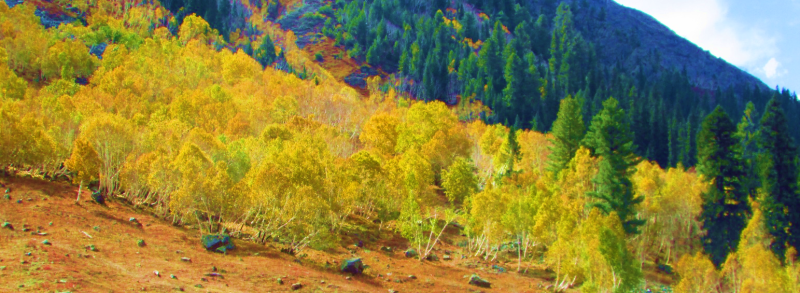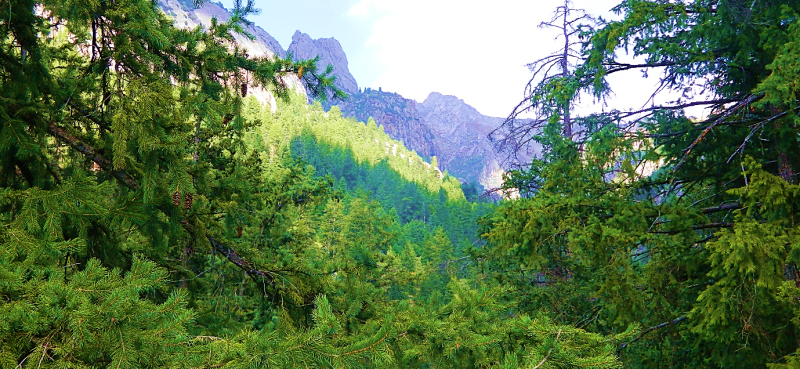
Quercus ilex (Fagaceae)
Home Common Name: Bani, Shah blaoot Local Name: Bani Description: Monoecious, evergreen or deciduous trees, rarely shrubs. Leaves are usually toothed or lobed, stipulate. Male
Forest, Wildlife & Environment Department Government of Gilgit-Baltistan
Biophysical context
Gilgit-Baltistan (GB) is located in extreme north of Pakistan beyond the effective reach of monsoon rains (between 35-37°N and 72-75°E) amidst Himalayas, Karakoram, Hindukush & Pamir mountain ranges. GB has a total geographical area of 7.04 million hectares, dominated by mountains (34%) and natural rangelands (46%), and followed by natural forest (3.58%). Cultivated agriculture lands, farm forests, cultivable waste and uncultivated waste constitute 10% geographical area (GBFD, 2016). Currently GB has an estimated population of 1.8 million with a low density of 25 person /km². With a meagre average of 0.10 ha per person agriculture land holdings scattered around 650 villages, dependency on natural resources still stands high (GOP, 2019). Based on ecological zonation five main types of forests exist in Gilgit-Baltistan, namely, Mountain Sub-Tropical Scrub, Mountain Dry Temperate Coniferous, Mountain Dry Temperate Broadleaved, Sub-Alpine and Northern Dry Scrub.
The landscape of the proposed program areas is predominantly dominated by some of the world’s highest mountains, with several peaks over 8,000 meters. Separating the mountains are a number of narrow valleys carved by rivers and streams (including the Indus and its tributaries). Much of the area lies in a rain shadow, receiving less than 200 mm of rain annually, though higher elevations may receive up to 2,000 mm of snowfall each year. Snow melt provides a permanent water source, feeding rivers and streams. Habitat types are determined by both altitudinal and climatic factors, in turn influencing the distribution of plants and animals. The main habitats include the Dry Alpine and Permanent Snowfield Zone, the Himalayan Alpine Zone, and Dry Temperate Coniferous Forests
Biodiversity
Gilgit-Baltistan is rich in biological diversity due to the extreme altitudinal differences and associated changes in climate, soil conditions and variation in aspects and exposure of slopes to solar radiation. A number of globally significant species of mammals are found in the area including some of the endangered species like the snow leopard, Himalayan brown bear, Marco Polo Sheep, Ladakh urial, flare horned Markhor, musk deer, and woolly flying squirrel. Similarly, a number of plant species of great economic and conservation values found in the area, including wild cumin, thyme, pine nuts and several other species of medicinal values. Keeping in view the significance of the flora and fauna 05 national Parks, 02 Wildlife sanctuaries, 04 Game reserves and 48 Community Controlled Hunting Areas (CCHA) have been created in Gilgit-Baltistan to protect biological resources of the region.
Forest
Pakistan has about 4.1 percent of area under forests, a considerable portion of which falls in non-productive category and unfit for commercial exploitation, except for meeting petty domestic requirements of connectionists living in the vicinity of forest habitats. Gilgit-Baltistan possesses almost the same ratio of forest resources. The district-wise proportion of forest resources in Gilgit-Baltistan however, greatly differ i.e. Diamer (30%), Astore (12%), Gilgit (0.5%), Skardu (< 0.5%) and Ghanche (< 0.3%). The farm-forestry component under community sector is 0.66 %, which is a fairly uniform figure for all districts in Gilgit-Baltistan. Since the region falls in a rain shadow area, beyond the effective reaches of Monsoon rainfalls in the inner Himalayas, the region serves as a cold desert with extreme climatic conditions. These extreme climatic conditions restrict the spread of forests, in contrast to the moist temperate forests situated in outer Himalayas. The natural forests in GB covers an area of 2492.05 sq km (3.58% of the total land), which falls under two broad categories, viz., Private Forests and State-owned Protected Forests. The Private Forests, which forms the bulk of the forest resources in GB (71% of the total forest wealth) are privately owned forests, regulated and managed by the Department in accordance with the Accession Deed 1952 and Gilgit-Baltistan Forest Act 2019. All the forest in Diamer District are Private Forests. The stated owned Forests, found across Gilgit-Baltistan except Diamer District are Protected Forests, where Government has the proprietary rights, and local resident communities have certain rights and concessions admissible under the law. These forests are over all classified as Himalayan dry temperate forests. However on higher elevations, sub-alpine forests and alpine scrub lands/forests are also found. In lower reaches of GB along indus from Sumar nala to Bunji Area, small patches of sub-tropical dry scrub vegetation is found.
Gilgit-Baltistan has an agro-silvi-pastural economy, being practice since centauries. Locals practice farm forestry for subsistence living for cooking purpose, and specially for heating purpose during the harsh and chilling winter months. The department, during 1950’s and 1960’s established a number of forest plantations along river beds, marginal lands and state properties to incentivize and subsidize the general public for production of timber and fire wood with a view to decrease pressure on natural forests, soil conservation measures and public service in its capacity as a national building department. This centauries old practice of farm forestry got momentum and significant boost with the inception of AKRSP in 1980’s. Realizing the importance of farm and social forestry, Gilgit-Baltistan, Forest Department has also emphasized for promotion of social forestry through establishment of great numbers of Government owned and Private nurseries, and through different incentive mechanisms to accelerate the pace of development of social and farm forestry. Currently the Department owns 66 numbers of Government plantations and 56 nurseries across GB.

Home Common Name: Bani, Shah blaoot Local Name: Bani Description: Monoecious, evergreen or deciduous trees, rarely shrubs. Leaves are usually toothed or lobed, stipulate. Male

Home COMMON NAMES: Bhurj Patta, BirchLocal name: Jonzi, Taliyang Description: Trees or small shrubs, 2-15 m tall. Bark peeling horizontally, white, brownish or reddish-white. Young

Home Common name: Kachel, Himalayan Spruce Local name: Kachul, Raien Description Trees to 60 m tall and 200 cm dbh, with a conical crown

Home Common name: Juniper Local name: Chili, Gal Description “Habit: tree, occasionally a shrub or a prostrate shrub, max. height 20-25 m, dbh 1.5-2.5 m